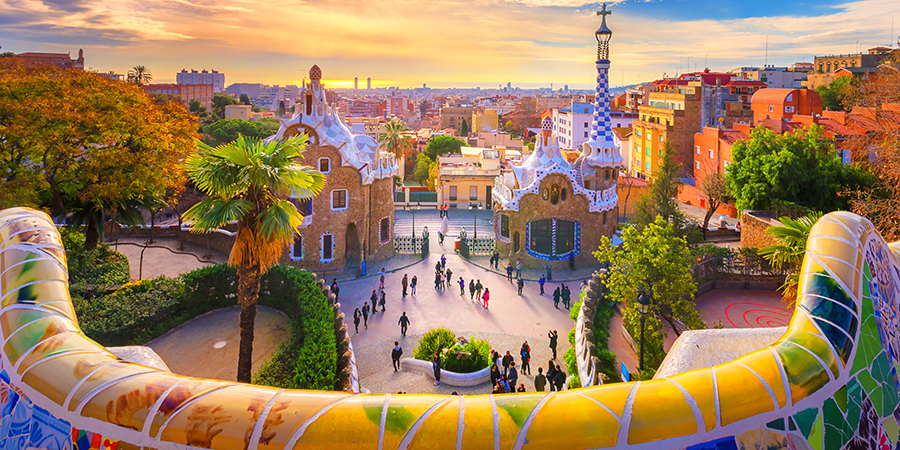$798$13,600

Spain, a country on Europe’s Iberian Peninsula, is characterized by diverse cultures, languages, historical sites, and landscapes. From the sun-soaked Mediterranean beaches to the green mountains of the north, the vibrant cities, and the arid plains of the south, Spain offers a rich and varied experience for every traveler.
Geography and Climate
Spain’s geography is remarkably diverse. It includes the mainland, the Balearic Islands in the Mediterranean, and the Canary Islands in the Atlantic Ocean. The climate varies significantly across regions, from the temperate in the north to the Mediterranean in the south and east, and semi-arid in the southeast.
Culture
Spanish culture is a vibrant mix of historical influences including Roman, Moorish, and Catholic. It’s renowned for its festivals, culinary traditions, and arts, particularly flamenco music and dance, and the works of artists like Picasso and Dalí.
Key Destinations
- Madrid – The capital city, known for its cultural landmarks, vibrant nightlife, the Prado Museum, and the Royal Palace.
- Barcelona – The capital of Catalonia, famous for Gaudí’s architecture including Sagrada Família, and the bustling La Rambla street.
- Seville – The heart of Andalucia, known for flamenco dancing, the Alcázar castle, and the Cathedral, the final resting place of Christopher Columbus.
- Granada – Home to the Alhambra, a stunning Moorish citadel and palace, and the historic Arab Quarter, Albaicín.
- Valencia – Known for the City of Arts and Sciences, the Turia Gardens, and the Fallas Festival.
- Bilbao – Famous for the Guggenheim Museum Bilbao and its innovative architecture.
- The Balearic Islands – Including Mallorca, Menorca, Ibiza, and Formentera, known for their beautiful beaches, clear waters, and vibrant nightlife (especially Ibiza).
- The Canary Islands – Known for their black and white sand beaches, diverse landscapes, and the Teide volcano.
Art and Museums
Spain’s art scene is world-renowned, with museums like the Prado in Madrid, the Guggenheim in Bilbao, and the Picasso Museum in Barcelona. The country’s history of art includes masters like Velázquez, Goya, Picasso, and Dalí.
Cuisine
Spanish cuisine varies widely across regions but is known for dishes like paella, tapas, and gazpacho. Spain is also famous for its wines, including Rioja, cava, and sherry, and regions like La Rioja are known for wine tourism.
Festivals and Traditions
Spain hosts a variety of festivals throughout the year. Notable ones include La Tomatina, the Running of the Bulls in Pamplona, Semana Santa (Holy Week), and numerous summer ferias.
Outdoor Activities
Spain’s diverse landscapes offer a plethora of outdoor activities. These include skiing in the Pyrenees, surfing in the north, hiking in the national parks, and sunbathing on the Mediterranean and Atlantic beaches.
Architecture
Spain’s architecture is a testament to its diverse history, from Moorish palaces and Roman ruins to Gothic cathedrals and modernist landmarks. Antoni Gaudí’s works in Barcelona are a highlight, as are the Moorish Alhambra in Granada and the medieval walls of Ávila.
Best Time to Visit
The best time to visit Spain generally is during the spring (March to May) and fall (September to November) when the weather is pleasant, and tourist crowds are smaller. Summers can be very hot, especially in the south, while winters are mild in the south and colder in the north.
Nightlife
Spain is famous for its vibrant nightlife, particularly in cities like Madrid, Barcelona, and Ibiza. The country is known for its late-night dining culture and a wide array of bars, clubs, and flamenco venues.
Beaches
Spain boasts some of Europe’s most beautiful beaches, from the family-friendly beaches of the Costa Brava to the secluded coves of the Balearic Islands and the white sand beaches of the Canary Islands.
Cultural Etiquette
Spanish people are generally warm and welcoming. Greetings are friendly, often with a handshake or a kiss on both cheeks. Dining is a leisurely affair, with lunch being the main meal of the day.
Safety
Spain is a safe country to travel to, with low rates of serious crime. Pickpocketing and petty theft can occur in tourist areas and major cities, so standard precautions should be taken.
Transportation
Spain has an extensive public transportation network, including high-speed trains (AVE), regular trains, and buses. Major cities like Madrid and Barcelona also have efficient metro systems.
Accommodations
Spain offers a wide range of accommodations, from luxury hotels and resorts to budget hostels, rural guesthouses (casa rurales), and vacation rentals.
Shopping
Spain offers diverse shopping experiences, from luxury boutiques and department stores in major cities to local markets and artisan shops selling traditional crafts and souvenirs.
Language
The official language is Spanish, with regional languages like Catalan, Basque, and Galician also spoken in their respective regions. English is widely spoken in tourist areas and major cities.
Healthcare
Spain has a high standard of healthcare. Travelers from the EU can access healthcare services with a European Health Insurance Card (EHIC), while others should ensure they have adequate travel insurance.
Tips for Travelers
- Tipping is customary in restaurants and for services, but not obligatory.
- Lunch is typically served from 2 pm to 4 pm, and dinner from 9 pm onwards.
- Siesta time in the afternoon, especially in smaller towns and rural areas, means many businesses close temporarily.











Spain
6 Days
$3,960
Take indulgence and beauty to the next level on this luxurious rail journey traversing northern Spain from Santiago de Compostela to Bilbao.









